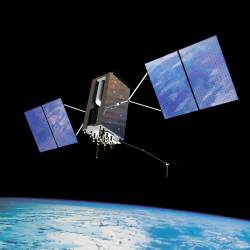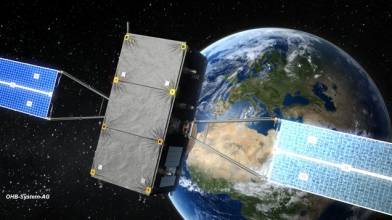 GPS IIIA. Lockheed Martin graphic
GPS IIIA. Lockheed Martin graphicThe Lockheed Martin team developing the next-generation GPS III satellites has successfully completed a major program milestone, the preliminary design review (PDR) conducted by the U.S. Air Force’s GPS Wing.
Underlining the importance placed on meeting a 2014 first-launch schedule, nearly 150 representatives from the GPS Wing and user communities, including representatives from the Department of Defense, the Joint Chiefs of Staff, Air Force Space Command, the Department of Transportation, and the Federal Aviation Agency participated in the four-day Space Vehicle PDR at Lockheed Martin Space Systems facilities in Newtown, Pennsylvania.
The Lockheed Martin team developing the next-generation GPS III satellites has successfully completed a major program milestone, the preliminary design review (PDR) conducted by the U.S. Air Force’s GPS Wing.
Underlining the importance placed on meeting a 2014 first-launch schedule, nearly 150 representatives from the GPS Wing and user communities, including representatives from the Department of Defense, the Joint Chiefs of Staff, Air Force Space Command, the Department of Transportation, and the Federal Aviation Agency participated in the four-day Space Vehicle PDR at Lockheed Martin Space Systems facilities in Newtown, Pennsylvania.
“The on-schedule completion of the PDR phase is an important design milestone giving the U.S. government high confidence we’ll meet our worldwide performance commitments,” said Col. Dave Madden, the GPS Wing commander.
Completion of the PDR milestone validates that the design meets military and civil requirements and advances the GPS III program into the critical design review (CDR) phase.
“This spacecraft preliminary design review was clearly outstanding and fully demonstrates the success of our early emphasis on systems engineering and mission success,” said Lt. Colonel Don Frew, GPS III squadron commander. “I’m very proud of the entire GPS III team, and look forward to the challenge of reaching critical design review.”
The issue of GPS sustainment has gained increased attention in recent weeks following a Government Accountability Office (GAO) report warning of a potential “gap” in GPS satellite availability.
Dave Podlesney, Lockheed Martin’s GPS III program director, said, “The quality of the PDR demonstrates the maturity of our design, our readiness to enter the next development phase, and the entire team’s dedication to keeping the GPS constellation strong.”
Lockheed Martin, along with teammates ITT and General Dynamics, completed a comprehensive spacecraft segment PDR, which represented the culmination of 70 subsystem and assembly PDRs, executed over the past six months.
Lockheed Martin is working under a $3 billion contract awarded by the GPS Wing in May 2008. The contract consists of design and development of the first two space vehicles (SV-1 and SV-2), options for up to 10 additional production vehicles, and a capability insertion program that allows the addition of mature technology to future increments.
The Air Force Joint Requirements Oversight Committee (JROC) decided to split the program into three increments to reduce risk and ensure on-time delivery of critical initial capabilities to U.S. military users.
The GPS IIIA program delivers all baseline signals delivered on current on-orbit GPS IIRM satellites, plus enhanced earth coverage M-code signal power, an L5 civil signal, and a new L1C civil signal compatible with the European Galileo program. GPS IIIA also provides a integrated growth path to GPS IIIB and GPS IIIC capabilities.





